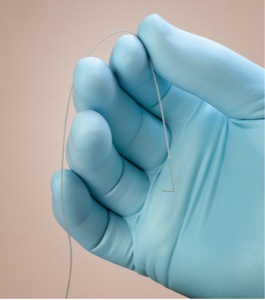Dr. Brian M. Ilfeld, MD, MS, feels this strongly about the potential for ultrasound-guided percutaneous peripheral nerve stimulation. It’s a technology that he says has the potential to forever change the way anesthesiologists treat acute postoperative pain. He discussed the results of a prospective feasibility study. As well as the potential for the technology’s future—at the 2016 annual Regional Anesthesiology and Acute Pain Medicine meeting (abstract A1265).
Gradually, a Technique Emerges
“There were very early reports of using electricity applied cutaneously to provide analgesia following surgical procedures,” said Dr. Ilfeld. He is a professor of anesthesiology in residence at the University of California, San Diego. “It never went very far, because you need to turn up the current so high to trigger the deeper target nerves that the skin’s sensory nerves fire, and it hurts so badly that you ended up inducing more pain than you are relieving.”
Other novel innovations used an implantable electrode placed around the peripheral nerve itself. While there has been some success with this approach, it has been historically extremely invasive. Requiring surgery with general anesthesia to both implant and extract the electrode. “So it was a pretty big deal in the last few years when there were scattered reports of percutaneously inserted leads providing postoperative analgesia,” Dr. Ilfeld said. While early leads didn’t fare particularly well due to design flaws, innovations in lead manufacture and the advent of ultrasound guidance may have ushered in a new era for this technology.
How It’s Used
To help determine the feasibility of the technology to provide analgesia for acute postoperative pain, Dr. Ilfeld and his colleagues studied it in five patients undergoing primary unilateral total knee arthroplasty. Patients were excluded if they:
- suffered any postoperative complications that would place them at increased risk—such as deep vein thrombosis;
- had an infection;
- had an implanted cardiac pacemaker/defibrillator or deep brain stimulator;
- had a bleeding disorder (or international normalized ratio ≥1.5 for those on warfarin); and
- had any confounding conditions, such as nerve damage or unrelated pain in the affected lower limb.
During the Study
In each case, the needle electrode (SPR Therapeutics, Cleveland) was inserted to within 0.5 to 3.0 cm of the femoral and/or sciatic nerve trunks under ultrasound guidance, and then replaced with a coiled fine-wire lead using the same technique. Nerve stimulation was delivered with an external pulse generator at 15 to 200 <03BC>sec, 0.2 to 20.0 mA and 100 Hz to evoke comfortable sensations in the painful area. The researchers assessed pain (0-10 numerical rating scale) at rest, and range of motion with the stimulation off and on. The intervention was assessed between eight and 58 days after surgery; leads were removed after assessment.
As Dr. Ilfeld revealed, patients reported average pain relief of 93%. Indeed, each patient reported clinically significant reductions in pain (≥50%) almost immediately. “My experience is that you turn on the stimulator and the relief is instantaneous,” he told Anesthesiology News. “And a little smile comes on their face because they almost can’t believe it. And that makes a smile come on my face because I almost can’t believe it.” With the stimulation off, three patients had pain levels of at least 4; no patient had pain of at least 4 once the stimulation had been turned on. Four of five patients reported complete (100%) pain relief.


